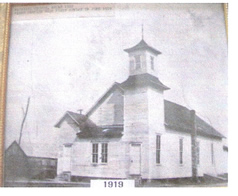 |
|
The History of Cowan First Church of the NazareneBy: L. Jarod Pearson
In order to understand the history of Cowan First Church of the Nazarene, we must first consider the history of the Wesleyan-Holiness movement of the 19th Century. The Wesleyan aspect of the movement traces back to John Wesley, a 17th-Century clergyman from England who led a spiritual awakening to emphasize repentance, testimony, and discipline. John Wesley was instrumental in the development of Methodism; however, the teachings and influences of John Wesley were carried far beyond Methodism itself. The Church of the Nazarene is one example. The Holiness aspect of the movement was a 19th-Century phenomenon where Wesleyan tradition met a renewed emphasis on purity, personal perfection and entire sanctification. The holiness movement helped reenergize the spread of Methodism in North America, but it also helped fuel the growth of Baptist, Pentecostal and even Presbyterian movements, particularly in rural areas. The Nazarene Church is a successor to this movement in the American religious landscape. The Wesleyan-Holiness movement was highly visible and effective in various parts of the country, and Tennessee was no exception. By the end of the 19th Century, there were dozens of Holiness and Pentecostal churches throughout the nation with a traceable common heritage. In the early 20th-Century, various groups pulled together to form a common body and fellowship. In 1907, the common body was officially consecrated as the Pentecostal Church of the Nazarene. Congregations in the Wesleyan, Holiness, and Pentecostal traditions were already organized in Franklin County before the unification took place. After the unification, Nazarene Churches were formally organized in different parts of the county. The first meeting of the Nazarene congregation in Cowan took place in 1917. The small group met in the former Boiling Fork Baptist Church, itself a historical landmark dating all the way back to the Year 1826. (The Baptist congregation at Boiling Fork disbanded during the Civil War.) The congregation, formally named Cowan First Church of the Nazarene, was organized in 1918 by Rev. S. W. Strickland. There were thirteen charter members: Mrs. Ed Cowan, Mrs. Ella Hartford, Mrs. Haith Jernigan, Mrs. J.B. Sargent, J. W. Sargent, Mr. and Mrs. Reese Farris, Mrs. Cowan Kinningham, Mrs. J.S. Rollins, and Mr. Ben Moseley. The new church building was completed in 1919; however, construction may have been an ongoing effort as far back as 1917. The building was a white, wood frame building with a gabled roof, left offset front door and stoop, and a right offset tower topped with a bell cupola. The first worship service in the new building was held on Sunday July 6, 1919. In 1951 the church building was completely remodeled. The tower with the bell cupola was removed, the front door was moved from the left offset to the center, and the all exterior walls were covered in red brick. Sadly, the renovated structure caught fire on November 24th, 1954. The fire was contained; however, it started again and ended up destroying everything but the exterior brick walls. The incident was blamed on a faulty coal burning stove used to heat the building. The congregation met in a borrowed church building on North Hodges Street (that is today the New Birth Church of Jesus Christ). The church was rebuilt using the surviving brick walls. The first service in the reconstructed building was held on Easter Sunday, 1955. Even though Cowan’s population was in a slow decline for the next few decades, Cowan First Church of the Nazarene experienced steady growth. Around 1970 the church acquired a house on Elliott Drive to serve as a parsonage. The old parsonage next door to the church was combined with a newly constructed annex for added classroom and fellowship space. In the mid-1980’s the sanctuary was expanded with a larger choir loft while pews were added for the congregants. Cowan First Church of the Nazarene has provided many great civic leaders and town benefactors throughout its history. Every year the congregation host missionaries and other dynamic speakers as well as the annual revival. The church is also a founding member of the successful Cowan Ministerial Association. Other interesting facts about Cowan First Church of the Nazarene: Two ministers in the Nazarene denomination grew up in the Cowan church: Rhett Butler, a youth minister in Lebanon, Ohio, and Will Mackey, a pastor in Colorado Springs, Colorado. A long-time member of Cowan Nazarene Church hasn’t attended church in years, but she never misses a Sunday! Mrs. Peggy Nelson has been homebound for more than 20 years, but her church family never fails to bring her a video-recording of the Sunday service. Rev. Carlos Sparks served two terms as pastor of the Cowan Nazarene Church, the first one from 1958 to 1967 and the second from 1989 to 1994. During his first term as pastor, Bro. Sparks served as Mayor of Cowan, president of Cowan Commercial Club, and co-founder of the Cowan Christmas Parade. He is also the author of several books, one of which received a favorable review in the New York Times. (Copies of Rev. Sparks’ books can be checked out at Cowan Branch Library.) The information used in this article was gathered and published by Rev. Wayne Morris who collected documents and interviewed some of the older church members. Other contributions were made by Rev. Norman Cox and by Mr. John Butler.
|

